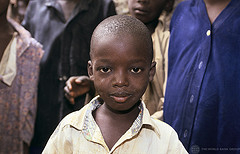
|
| UNICEF warns that cities are failing to meet the needs of children |
5 March 2012 -- Urbanization leaves hundreds of millions of children in cities and towns excluded from vital services, UNICEF warns in The State of the World’s Children 2012: Children in an Urban World. Cities offer many children the advantages of urban schools, clinics and playgrounds. Yet the same cities the world over are also the settings for some of the greatest disparities in children’s health, education and opportunities.
"When we think of poverty, the image that traditionally comes to mind is that of a child in a rural village," said UNICEF Executive Director Anthony Lake. "But today, an increasing number of children living in slums and shantytowns are among the most disadvantaged and vulnerable in the world, deprived of the most basic services and denied the right to thrive."
"Excluding these children in slums not only robs them of the chance to reach their full potential; it robs their societies of the economic benefits of having a well-educated, healthy urban population," Lake added. Greater urbanization is inevitable. In a few years, the report says, the majority of children will grow up in towns or cities rather than in rural areas. Children born in cities already account for 60% of the increase in urban population.
Infrastructure and services are not keeping up with urban growth in many regions, and children's basic needs are not being met. Families living in poverty often pay more for substandard services. Water, for instance, can cost 50 times more in poor neighborhoods where residents have to buy it from private vendors than it costs in wealthier neighborhoods where households are connected directly to water mains.
The deprivations endured by children in poor urban communities are often obscured by broad statistical averages that lump together all city dwellers—rich and poor alike. When averages such as these are used in making urban policy and allocating resources, the needs of the poorest can be overlooked.
Making cities fit for children
A focus on equity—giving priority to the most disadvantaged children wherever they live—is crucial.
UNICEF urges governments to put children at the heart of urban planning and to extend and improve services for all. To start, more focused, accurate data are needed to help recognize disparities among children in urban areas and identify how to bridge them. The shortage of such data is evidence of the neglect of these issues.
While governments at all levels can do more, community-based action is also a key to success.
The report calls for greater recognition of community-based efforts to tackle urban poverty and gives examples of effective partnerships with the urban poor, including children and adolescents.
These partnerships yield tangible results, such as better public infrastructure in Rio de Janeiro and Sao Paulo, Brazil; higher literacy rates in Cotacachi, Ecuador; and stronger disaster preparedness in Manila, Philippines. In Nairobi, Kenya, adolescents mapped their slum community to provide information to urban planners.
Oportunidades, an initiative that began in Mexico and helped pioneer cash transfers that increased the ability of the poorest families to send their children to school and pay for health care, has been scaled up in both rural and urban areas, and provided valuable experience for countries that followed Mexico’s example.
At the global level, UNICEF and the United Nations Human Settlements Programme (UN-Habitat) have worked together for 15 years on the Child-Friendly Cities Initiative building partnerships to put children at the center of the urban agenda, to provide services, and to create protected areas so children can have safer and healthier childhoods.
"Urbanization is a fact of life, and we must invest more in cities, focusing greater attention on providing services to the children in greatest need," Lake said.
About UNICEF
UNICEF has saved more children's lives than any other humanitarian organization in the world. Working in more than 150 countries, UNICEF provides children with health care, clean water, nutrition, education, emergency relief, and more. The U.S. Fund for UNICEF supports UNICEF's work through fundraising, advocacy, and education in the United States.
UNICEF is at the forefront of efforts to reduce child mortality worldwide. There has been substantial progress: the annual number of under-five deaths dropped from more than 12 million in 1990 to 7.6 million in 2010. But still, 21,000 children die each day from preventable causes. Our mission is to do whatever it takes to make that number zero by giving children the essentials for a safe and healthy childhood. For more information, visit www.unicefusa.org.




